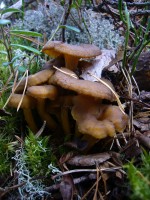 Also called trumpet chanterelle and winter chanterelle, this mushroom is widespread and common throughout the northern North America growing in large colonies in wet sites of deciduous and coniferous woods during the fall into December. It is mycorrhizal especially with older spruce trees, Douglas-fir, and western hemlock but can also be found on rotting logs. It’s dull color and small size allows it to blend into the moss, or leaf or needle litter of its habitat and so it is often difficult to find.
Also called trumpet chanterelle and winter chanterelle, this mushroom is widespread and common throughout the northern North America growing in large colonies in wet sites of deciduous and coniferous woods during the fall into December. It is mycorrhizal especially with older spruce trees, Douglas-fir, and western hemlock but can also be found on rotting logs. It’s dull color and small size allows it to blend into the moss, or leaf or needle litter of its habitat and so it is often difficult to find.
The tube-shaped mushroom stands 2-4 ½ inches high and has a cap ½ to 2 ½ inches across. The cap is domed at first but deeply funnel-shaped with age, and has an inrolled margin that becomes wavy, irregular. The surface of the cap is various shades of brown and often dry and slightly downy. The dull yellow to gray gill-like veins are forked wrinkled, and extend slightly down the stem. The stem is somewhat hallow and opens to the top of the cap. It has a wrinkled surface and is yellow at first turning bright orange with age. The spores are white.
The tubular chanterelle is considered very good to eat because of its taste and consistency. It is peppery and smokey when raw and slightly elastic in texture. It is less fleshy than the more popular C. cibarius but is found in such profusion that a large number can be harvested in one outing. The mushrooms are good sautéed in butter and can be added to béchamel sauces and used with chicken, pork, fish, pasta, and rice dishes. Their subtle flavor is good in an omlet, and with some vegetables, and cheeses.
Photo Credit: By Amphis – Own work, Public Domain, Link